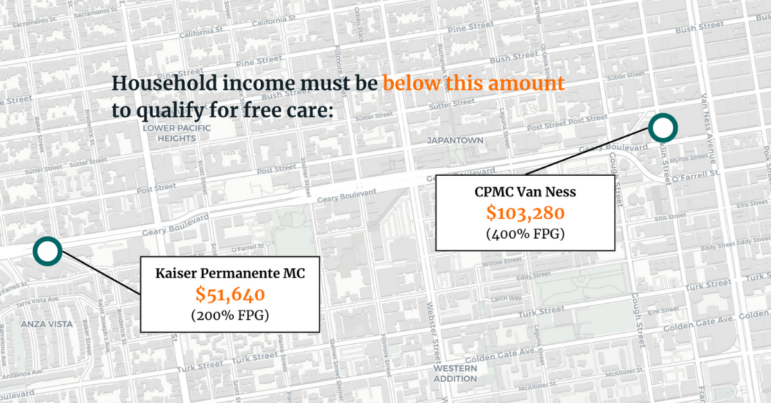Nonprofit hospitals are required to have a financial assistance policy—a written policy that outlines which patients are eligible for free or discounted care based on their income and other criteria. However, there are no federal requirements for eligibility, and only a few states have rules outlining who is eligible for assistance. This can lead to wide variation in how hospitals give out free and discounted care.
Here are a few example of what this looks like, from the Lown Institute’s current project on hospital billing practices. Visit our project page to learn more about the data we are collecting and watch the video recording of our recent webinar on medical debt.
Variation in free care policies
The Lown Institute has data on financial assistance and collection policies currently available for 1,250 hospitals. Among these hospitals, most have financial assistance policies that set eligibility for free care at household income under 250% of federal poverty guidelines (FPG). For a family of three, 250% of FPG is an annual income of $64,550.
But there is a lot of variation in our data set, with some hospitals offering free care for patients at 450% of the FPG and others granting eligibility to patients making only 150% FPG. In fact, we see substantial variation in free care eligibility even for hospitals in the same cities.
Source: The State of Medical Debt event, Lown Institute, May 14, 2024.
A tale of two cities
In Boston, at Brigham and Women’s medical center, patients making below 150% FPG are eligible for free care (that’s $38,730 annual income for a family of three). But just a ten minute walk away at Beth Israel Deaconess Medical Center, patients making 400% FPG are eligible for free care ($103,280 for a family of three). That’s a $65,000 difference in annual income for free care eligibility.
Similarly in San Francisco, CPMC Van Ness Hospital has a income eligibility requirement of under 400% FPG for uninsured patients, while Kaiser Permanente Medical Center has a free care income eligibility requirement of under 200% FPG, regardless of patients’ insurance.
Income eligibility for free care doesn’t tell the entire story of a hospital’s generosity— hospitals may have different eligibility rates for care discounts, asset tests for eligibility, assistance for large bills, or may exclude certain services or providers from assistance entirely. However, these examples show the great leeway that hospitals have to craft their own policies, and how it can make it more complicated for patients to access free care. In some cases, turning left or right at an intersection can be the difference between going into medical debt for thousands of dollars, or not.
